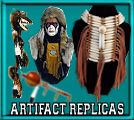|
|  |

Potawatomi Indian Crafts
Potawatomi Indians were known for their quill embroidery,
basketry, and floral beadwork.
Potawatomi crafts are known for their quill embroidery, woven basketry, and floral beadwork. The Potawatomi crafters and other eastern American Indians also crafted wampum out of white and purple shell beads to use as regalia, currency, and commemoration of important events. Like European tapestries or Celtic tartans, the designs and pictures on a wampum belt often told a story or represented family affiliations.
The Potawatomi Cultural Center and Museum in Crandon, WI is a great place to learn more about the Potawatomi tribe, its native lands, history and culture. It houses an archive, a library, a cultural hall and a 2,700 square foot permanent exhibit entitled: "People of the Three Fires."
This extensive exhibit is divided into four main sections. The first, entitled "The Long Walk," details the history of the Potawatomi. The second is an interactive language section, entitled "People Who Share a Language."
The third is a display of different traditional elements, including Potawatomi crafts, called "Traditional," with the last section devoted to the heritage of the present day tribe.
Other areas of interest within the Museum include the Wall of Treaties with replicas of each of the forty-three American and seven Canadian treaties that have been signed by the U.S. government and the Potawatomi.
The Forest Potawatomi have not woven textiles for a long time, although they used to do so. In earlier days, they used tanned buckskin for clothing, sewing it with native fibers and sinew. They wove a kind of cloth from cedar bark and from bast fibers. Woven bags of bast fibers were used for storage vessels.
The Forest Potawatomi still weave rush mats and cat-tail mats. They also make ash splint baskets and fashion miniature birch bark canoes as well as other knicknacks for the tourist trade.
The Forest Potawatomi used the maple leaf as a pattern for much of their beadwork and appliques. In making up a design for art work or bead work, the Potawatomi woman would burn deer antlers until they turned to charcoal and use this to rub on the backs of the leaves. This surface was placed down upon a piece of white birch bark and rubbed until the shape and venation of the leaves were transferred to the birch bark. Then arranging with other leaves, a design would be formed which would be the pattern for the bead work. Oftentimes this would be placed directly under the loom so that the form and outline of the finished beadwork would be a true representation of the natural object.
Before Europeans brought glass trade beads, their beads were fashioned from native shells and were rather coarse and irregular. They also used porcupine quills for ornamenting their articles of buckskin clothing. When the smaller, more uniform trade beads became available, the Potowatomi began to use mostly trade beads in their beadwork.
Add to this resouce by posting your potawatomi craft articles or corrections here. If you are suggesting a correction, please give the URL of the page the error is on.
POTAWATOMI CRAFT ARTICLES:
How to Weave a Cattail Mat
OTHER CRAFT SUBJECTS:
Make your own paints
How to make a corn husk doll
How to make a quality hand drum
How to make rawhide
Hopi silver jewelry is a modern craft
Iroquois beadwork displayed at the George Gustav Heye Center
Across Borders: Beadwork in Iroquois Life
What is sterling silver, anyway?
Common Indian Symbols used in Indian jewelry
Hopi Basketry techniques and uses
An introduction to Hopi Basketry
Are Dream Catchers Losing the Native Tradition?
Anishnaabek (Ojibwe) interpretation of the medicine wheel
Zuni tradition lives in fetishes
|
 | 
OUR SPONSORS:
If you sign up from the above link, drop us an email and we'll give you some tips to help you get started making money FAST with targeted ads. This sponsor pays our rent every month.

Webmasters Make $$$
We make the car payment and pay the utilities with this affiliate program. Sign up from the link above, then shoot us an email with your member name and we'll be glad to give you some pointers that will really make a difference in your bottom line.

This program allows you to choose to advertise a wide range of products, so you can find ads that are a great fit with your site content, which really increases sales. When you sell something, they pay you a commission. We earn our entire income from the three programs above, and were able to quit our day jobs. Give it a try!
|









